There are just too many cool things blooming in my colleague’s garden to not get some more pictures. Some may seem to be redundant to others that were shared earlier, as well as to some that have not been shared yet. The unknown salvia and lion’s tail are finishing their bloom, as it the know what time of year it is. The weather may not seem like that of late summer, but they know otherwise. I got these pictures while I could. African iris and African daisy are oblivious. They bloom whenever they want to, and African iris can even bloom a little bit through winter if it chooses to. Autumn sage, as the name implies blooms best about now. Of these six, only the four O’clock will deteriorate in autumn and die back through winter. The salvias will get pruned back anyway.
1. Four O’clock, Mirabilis jalapa, are the same as those featured last Saturday in Six on Saturday, and in the following brief article about the individual plants that bloom with flowers of different colors. This one looks like a blob of mustard with a bit of ketchup that squirted out of a hamburger as someone bit into it. The rich red flower in the background that looks more like plain ketchup is on the same stem.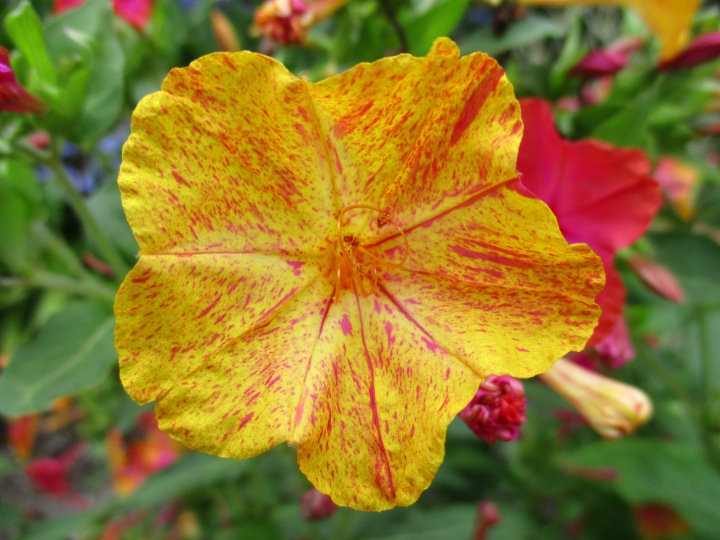
2. Autumn sage, Salvia gregii, is a different cultivar of the same species featured yesterday. The picture that was posted yesterday was from a specimen in the landscape at the library in town. This picture is that of a cultivar of smaller stature but with bigger flowers. The zonal geraniums of questionable (pink, salmon, peach or whatever) color that were featured last week can be seen in the background.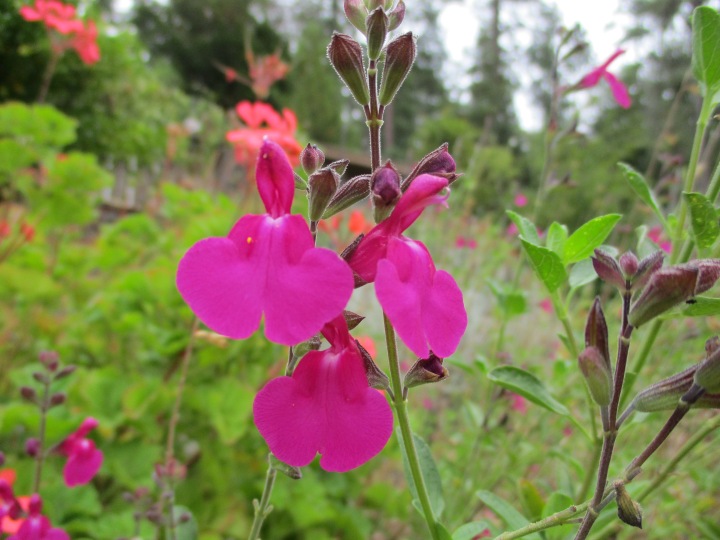
3. Black and blue salvia, Salvia guarantica, looks just like this. . . or this looks just like black and blue salvia. I really do not know what it is. It sure is an exquisite blue though. The base of the plant is rather scrawny, almost as if it intends to grow only as an annual. It will get cut back like other salvias, but not as aggressively. If it regenerates from the base like it should, the old growth can be cut back later.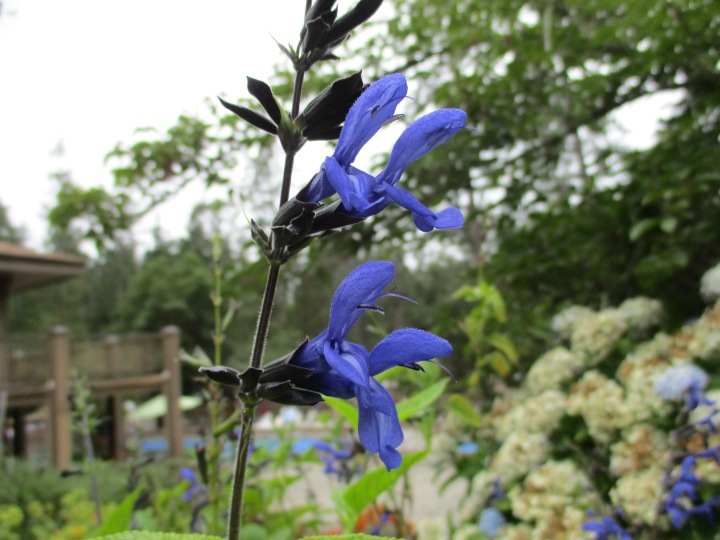
4. Yellow African iris, Morea bicolor, is sort of cliché. However, this is the only one anywhere around. Seriously, with all the many acres of landscape that my colleague maintains out there, this is the only one. The more common white African iris, Dietes iridioides, is lacking completely. (‘Dietes‘ and ‘Morea‘ are synonyms, but ‘Dietes‘ is uses more for the ‘iridiodes, and ‘Morea‘ is used more for the ‘bicolor‘.)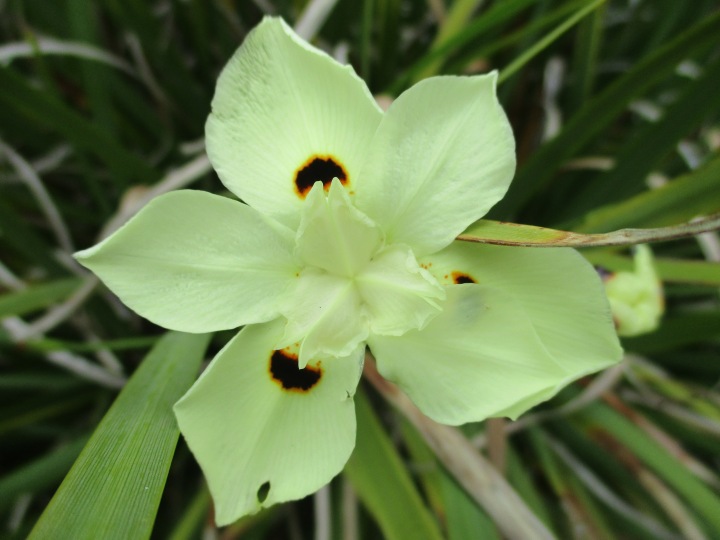
5. African daisy, Osteospermum ecklonsis, looks something like gazania. There are plenty pictures of gazania as well, but I will use them for the next two weeks. This species of African daisy is shrubbier and more colorful than the sprawling types that were popular as ground cover back in the 1980s. It blooms more profusely, and with more vivid colors. I probably should have gotten pictures of the other colors too.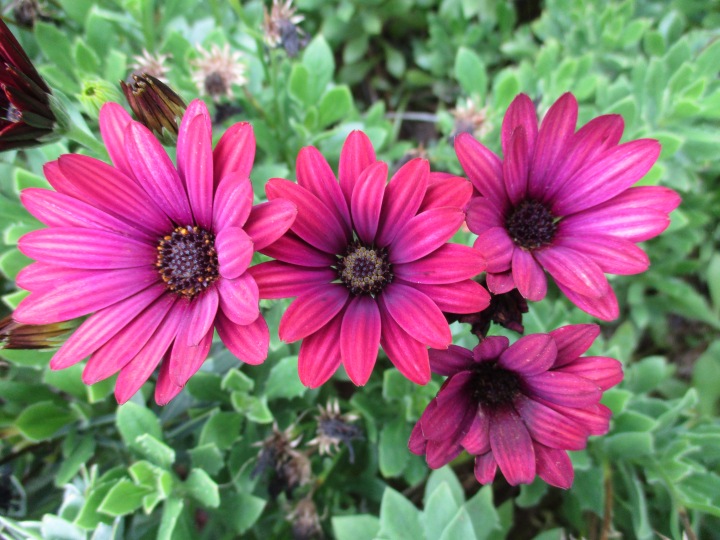
6. Lion’s tail, Leonotis leonurus, will be featured in my weekly gardening column this week, which shows up here on Tuesday. I am no fan of orange, but I can not dislike this bloom. The color is as flashy as that of California poppy. I will never understand why this perennial is not more popular than it it. It has been available longer than some of the less impressive salvias, but salvias are trendy. They are related of course.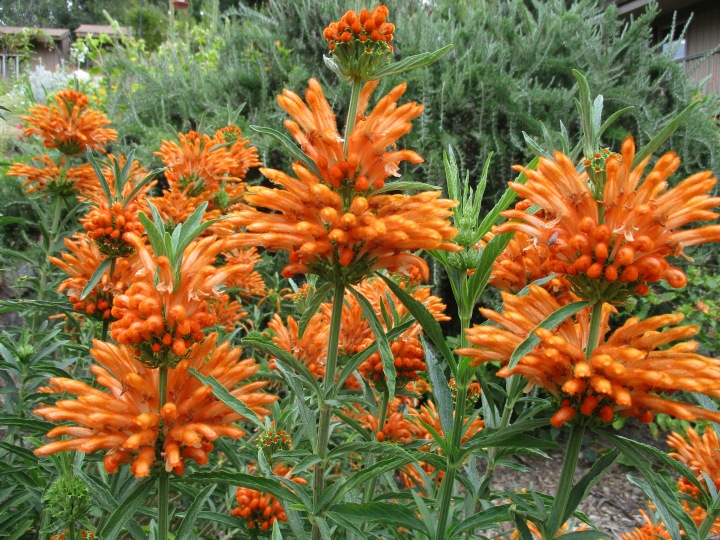
This is the link for Six on Saturday, for anyone else who would like to participate:
https://thepropagatorblog.wordpress.com/2017/09/18/six-on-saturday-a-participant-guide/
I have black and blue Salvia in my garden Tony. If you run the leaves do they smell like anise.
LikeLiked by 1 person
This particular specimen is not very aromatic at all. When the older flower stalks were pruned out, it did not smell like much of anything. I would have remembered an aroma of anise. I suppose I should try smelling it more directly. I am not quite convinced that it is black and blue salvia. All the other salvia are aromatic.
LikeLike
Because I am quite trendy, I like your Salvias. Leonotis is pretty cool too. Must cut my Salvias back now.
LikeLiked by 1 person
I sort of think that it is not necessary to be trendy to appreciate those salvias. Even I can like the modern cultivar of the old classic autumn salvia . . . because it is related to an old classic. (I hope that counts.) The black and blue is so striking, and so blue! I really dig it too . . . although I would not admit to it.
LikeLike
Moraea and Dietes might be clichés for you, but here where they only just survive outside, are choice exotics. Same thing, different angle.
LikeLiked by 1 person
I noticed that with lily-of-the-Nile too. People in the Northwest really think of them as something fancy. In Oklahoma, hey are potted plants that needed to be brought in for winter.
LikeLike
Those flowers are fabulous, you’re right! We do grow a lot of the blue salvia, ‘Black and Blue’ out here because it is so dramatic, but for us, everything is an annual only. They’re still worth growing though, and hummingbirds love them (even if they aren’t red).
Karla
LikeLiked by 1 person
There are only a few cultivars of only two genera of salvia that are annual here, but we grow neither.
LikeLike
The lion’s tail is spectacular – I haven’t seen it before. Is it well-suited to California?
LikeLiked by 1 person
It is quite well suited. The pruning is a bit trickier than that of related salvias. (I would tend to pruned it more aggressively, which it does not like.) It was available in the 1980s. I saw it for the first time when I was in school. I can not imagine why it is not more popular than it is.
LikeLiked by 1 person
The black and blue salvia is really cool. I saw it growing in the Hershey Gardens (in Hershey, PA, a beautiful public garden if you ever get a chance…) It has a striking presence in the border.
LikeLiked by 1 person
Salvias are supposed to be popular here because of our climate. Yet, one can never predict which ones will become trendy. This is another one of those many plants that really should be more trendy than it is. Some of the trendy ones are not as impressive. Yet, I believe that I have seen this (or something like it) in Portland, where watering is not such a concern.
LikeLike
Last year, I grew leonotis leonurus but not this time … Unfortunately, I didn’t keep seeds and I’m afraid that I only have 2 seeds left for next year … I do like these flowers! About the four o’clock flowers, you know what I think of them because we talked about them last weekend. This one is very pretty too.
LikeLiked by 1 person
I could have gotten more pictures of the four O’clocks, but they start to get redundant after a while. I am pleased that those who have them in their gardens do not necessarily dismiss them as weeds, even though we know that they are.
LikeLiked by 1 person
The yellow African iris is used by landscapers around here – a lot. I’ve not known its identity, but it pops up in median plantings and such. There’s one marina that uses it, and it really is a pretty plant. I’m glad you included it, and I’m glad I finally know what it is.
LikeLiked by 1 person
The white species used to be more common. Much of it dies in the really bad freeze in 1990. The yellow one had been uncommon but sought after prior to that, but was more available afterward.
LikeLiked by 1 person
I’m not a fan of orange either, but the Lion’s Tail is intriguing.
LikeLiked by 1 person
Yes! It is the sort of plant one can give to a neighbor! It looks great in ‘their’ garden, but I do not need to admit any affiliation with it, or that I really like it.
LikeLike
This is a lovely group of flowers — I particularly like the 4-o’clock and the African Iris!
LikeLiked by 1 person
Really? They are so opposite. The four O’clock is so brightly colored. The African iris is so pale.
LikeLiked by 1 person
I think that’s why I like them! Both good contrasts for the salvia, so common in t his part of the world. And the Lion’s Tale looks to me like a wannabe red hot poker or some such.
LikeLiked by 1 person
Oh, red hot poker. That is one I miss from Southern California. It seems to do better there, even in San Luis Obispo, which is the same climate zone as here.
LikeLiked by 1 person
I was such a fan of salvia black-and-blue a decade ago (or so) in Virginia that I featured it all along my driveway where it thrived. Such great contrast in that plant!
LikeLiked by 1 person
Yes, others have said the same. I just lie the blue It is such a perfect blue regardless of the black.
LikeLike
This is why SOS is so popular, it gives you plants you have never heard of before. I love the Lions Tail *thinks* must investigate – thank you!
LikeLiked by 1 person
I grew Leonotis for a couple of years but didn’t manage to get it through the winter. I don’t know the Iris but it’s gorgeous.
LikeLiked by 1 person
Lion’s tail is somewhat sensitive to frost; but frost is mild here. The iris does not really look much like iris. The foliage forms a tough grassy clump. It is tougher and more stout than grass, but looks more grassy than like iris foliage. The flowers are not as impressive as they are in the closeup picture. They are quite small and pale. It is popular here as a tough perennial, but is not grown for show like prettier iris are.
LikeLike
Great six Tony, I like that mustard and ketchup flower!
LikeLiked by 1 person
It does not taste like it looks, and it toxic too.
LikeLike
Love that salvia. Did you check it for aroma?
LikeLiked by 1 person
Others already asked abut that. I found that, although nicely aromatic, the autumn sage was not quite as aromatic as the simpler and not so overly bred cultivars are. (Those with smaller and less flashy flowers are more aromatic.) The black and blue salvia is likewise somewhat aromatic, but not as aromatic as it should be. It may be a different salvia. I just know it as black and blue salvia because that is what it looks like to me.
LikeLike
Your colleague is busy in the garden! Nice flower photos in both the “colleagues garden” posts!
LikeLiked by 1 person
Yes. The garden is used by ‘Outdoor Science’ classes at a campground. My colleague must maintain a weird variety of plants for particular lessons and classes.
LikeLike